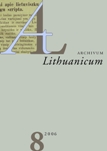Priesaginių veiksmažodžių daryba Kleino, Sapūno‒Šulco ir Hako gramatikose
The derivation of Lithuanian suffixed verbs in the grammars of Klein, Sappuhn-Schultz and Haack
Author(s): Jurgis PakerysSubject(s): Theoretical Linguistics, Semantics, Historical Linguistics, Baltic Languages, 17th Century, 18th Century
Published by: Lietuvių Kalbos Institutas
Keywords: Lithuanian language; suffixed verbs; Grammar analysis;
Summary/Abstract: The article focuses on the description of Lithuanian verb formation in the earliest printed grammars of Daniel Klein (Grammatica Litvanica, 1653, KlG; Compendium Litvanico‑Germanicum, 1654, KlC), Christoph Sappuhn and Teophil Schulz (Compendium Grammaticae Lithvanicae, 1673, SSchG), and Friederich Wilhelm Haack (Vocabularium Litthvanico‑Germanicum, et Germanico‑Litthvanicum, [...] Nebst Einem Anhang einer kurtzgefaßten Litthauischen Grammatic, 1730, HG). KlG and SSchG include separate chapters on verb formation (De verbi specie et figura), while KlC and HG offer only brief remarks on the subject. Introductory chapters on the verb (De verbo) in KlG and KlC describe derived reflexives and causatives as certain semantic types beside active, passive and neuter groups of verbs. SSchG includes the aforementioned formations in the chapter on verb formation only, and HG briefly mentions them after the chapters on conjugation. The grammars describe two basic ways of verb formation, viz. derivation and composition. The derivation covers suffixed verbs, but SSchG includes reflexives as well. The composites, according to the grammars, can be nominal (juokdarau ‘jocum facio’), adverbial (gandarau ‘satisfacio’), prepositional (prieimi ‘adeo’) or include “inseparable particles” (beesmi ‘adhuc sum’, da‑/pa‑lytėju ‘attingo’). The grammars usually list only derivatives and their bases are often omitted. The suffixes are referred to as the last two syllables of 1 sg. praes. and in many cases are segmented correctly. The meanings of derivatives are well expressed in Latin or German paraphrases which usually include the translation of the Lithuanian base word preceded by certain modifier(s). One verb is explained in Lithuanian and German: rašydinu ‘duomi rašyti, ich lasse schreiben’ (KlG). The categories of Lithuanian suffixed verbs are described in the verb formation chapters of KlG and SSchG, and bear certain resemblances as well as differences. KlG starts with inchoatives, but omits causatives, while SSchG does not mention the first category and includes the latter category referred to as “permissives”. KlG describes causatives in the introductory chapter of verb, labels them “transitive” (verba transitiva) and compares them to Hebrew hif’il formations. KlC and HG follow KlG, but HG leaves out the Hebrew parallel.
Journal: Archivum Lithuanicum
- Issue Year: 2006
- Issue No: 08
- Page Range: 211-232
- Page Count: 22
- Language: Lithuanian

